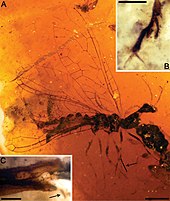1925 in paleontology
 From Wikipedia the free encyclopedia
From Wikipedia the free encyclopedia
| |||
|---|---|---|---|
| +... |
Paleontology or palaeontology is the study of prehistoric life forms on Earth through the examination of plant and animal fossils.[1] This includes the study of body fossils, tracks (ichnites), burrows, cast-off parts, fossilised feces (coprolites), palynomorphs and chemical residues. Because humans have encountered fossils for millennia, paleontology has a long history both before and after becoming formalized as a science. This article records significant discoveries and events related to paleontology that occurred or were published in the year 1925.
Plants[edit]
Angiosperms[edit]
| Name | Novelty | Status | Authors | Age | Unit | Location | Synonymized taxa | Notes | Images |
|---|---|---|---|---|---|---|---|---|---|
| Sp. nov | jr synonym | Eocene | A tetramelaceous leaf morphotype |
Arthropods[edit]
Insects[edit]
| Name | Novelty | Status | Authors | Age | Unit | Location | Notes | Images |
|---|---|---|---|---|---|---|---|---|
| Fam nov | valid | Extinct snakefly family |  | |||||
| Sp nov | jr synonym | Cockerell & Custer | An inocelliid snakefly |  |
Archosauromorpha[edit]
General pseudosuchian research[edit]
- Longman describes a crocodilian skull discovered at Lansdown Station in Australia, assigning it to the genus Pallimnarchus (now Paludirex).[8]
Newly named dinosaurs[edit]
Data courtesy of George Olshevsky's dinosaur genera list.[9]
| Name | Novelty | Status | Authors | Age | Unit | Location | Notes | Images |
|---|---|---|---|---|---|---|---|---|
| Gen et sp nov | Valid | Parks | latest Campanian/earliest Maastrichtian |  |
Newly named plesiosaurs[edit]
| Name | Status | Authors | Age | Location | Notes | Images |
|---|---|---|---|---|---|---|
| nomen invalidum | Rabeck | Mislabeling of an image, not a valid genus name |
Synapsids[edit]
Non-mammalian[edit]
| Name | Status | Authors | Age | Location | Notes | Images |
|---|---|---|---|---|---|---|
| Valid | Broom | 257 Millions of years ago | ||||
| Valid | Broom | |||||
| Valid | Broom | 257 Millions of years ago | A Dog-like Gorgonopsian. |  | ||
| Jr. synonym | Jr. synonym of Theriognathus. |
Mammals[edit]
| Name | Novelty | Status | Authors | Age | Unit | Location | Notes | Images |
|---|---|---|---|---|---|---|---|---|
| Gen et sp nov | Valid | Matthew & Granger | A didymoconid, type species is A. furunculus. | |||||
| Gen et sp nov | Valid | Matthew & Granger | A rodent, type species is A. olseni. | |||||
| Sp nov | Valid | Matthew & Granger |
References[edit]
- ^ Gini-Newman, Garfield; Graham, Elizabeth (2001). Echoes from the past: world history to the 16th century. Toronto: McGraw-Hill Ryerson Ltd. ISBN 9780070887398. OCLC 46769716.
- ^ Cockerell, T.D.A. (1925). "Plant and insect fossils from the Green River Eocene of Colorado". Proceedings of the U.S. National Museum. 66 (19): 1–13.
- ^ LaMotte, R.S. (1952). Catalogue of the Cenozoic plants of North America through 1950. Geological Society of America Memoirs. Vol. 51. Geological Society of America. doi:10.1130/MEM51.
- ^ Correa Narvaez, J. E.; Allen, S. E.; Huegele, I. B.; Manchester, S. R. (2023). "Fossil leaves and fruits of Tetramelaceae (Curcurbitales) from the Eocene of the Rocky Mountain region, USA, and their biogeographic significance". International Journal of Plant Sciences. doi:10.1086/724018.
- ^ Pérez-de la Fuente, R.; Peñalver, E.; Delclòs, X.; Engel, M.S. (2012). "Snakefly diversity in Early Cretaceous amber from Spain (Neuropterida, Raphidioptera)". ZooKeys (204): 1–40. doi:10.3897/zookeys.204.2740. PMC 3391719. PMID 22787417.
- ^ Cockerell, T. D. A.; Custer, C. (1925). "A New Fossil Inocellia (Neuroptera) from Florissant". The Entomologist. 58: 295–297.
- ^ Carpenter, F.M. (1936). "Revision of the Nearctic Raphidiodea (Recent and Fossil)". Proceedings of the American Academy of Arts and Sciences. 89 (2): 89–158. doi:10.2307/20023217. JSTOR 20023217.
- ^ Longman, H.A. (1925). "A crocodilian fossil from Lansdowne Station". Memoirs of the Queensland Museum. 8 (2): 103–108.
- ^ Olshevsky, George. "Dinogeorge's Dinosaur Genera List". Archived from the original on 2011-07-15. Retrieved 2008-08-07.
- ^ Parks, W. A. (1925). "Arrhinoceratops brachyops, a new genus and species of Ceratopsia from the Edmonton Formation of Alberta". University of Toronto Studies (Geological Series). 19: 5–15.
- ^ a b c Matthew, William Diller; Granger, Walter (1925). "New creodonts and rodents from the Ardyn Obo Formation of Mongolia". American Museum Novitates (193).